As a general rule of thumb, concrete underground tanks with slats over them and animals housed directly overhead (or the slurry scraped in from nearby passageways) are the cheapest form of slurry storage.
However, when volumes start to increase as livestock numbers on-farm rise, slurry storage on a grander scale – using lagoons or overhead towers – starts to come into play from a financial point of view, generally, above 250,000 gallons.
Overhead stores
Overhead slurry towers had been the go-to for many years, but Moore Concrete, based in Ballymena in Co Antrim, has seen a growing interest in its precast concrete storage systems.
The firm creates a variety of products for agricultural use including cattle and pig slats, water troughs, fencing posts and its pre-stressed wall panels.
Pre-stressed overhead slurry stores are not new to the company, with over 200 stores built across the UK and Ireland. The Danish technology used to create the stores has been in existence for over 30 years.
Size wise, the tanks can be built from 75,000 gallons right up to 1,000,000 gallons of storage with three different tower heights to chose from; 4m, 5m or 6m.
The 4m high panels can be used to build a tower with a maximum capacity of 692,560 gallons, with 5m panels capable of 863,280 gallons of storage.
The speed at which the overhead slurry stores can be created is impressive.
Farmers are responsible for organising the clearing and preparation of the site to a suitable level base of hardcore/gravel, with Moore Concrete responsible for the remainder of the build.
Day one of the build comprises setting up the base, with pouring occurring on day two.
The bases are created with 37N concrete and are left to cure for seven days post pour before any other work is complete.
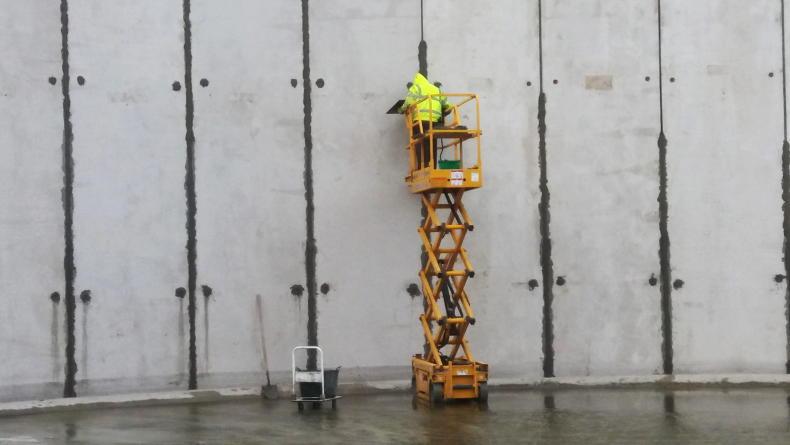
Joints are sealed internally using an expansive mortar.
On days nine and 10 of the build, the prestressed concrete panels arrive on-farm and are installed. The 6m wall panels weigh up to four tonnes, with a suitable crane used to install the panels.
Panels are propped intermittently with timbers, with the tongue and groove system of the panels allowing them to slot into each other. The post tensioning cables are then installed and given their initial stressing.
The steel cables themselves are encased in a greased PVC sheath to protect them from the elements and are threaded through holes on the outer surface of the panels.
On days 11 and 12, a special expansive mortar is used to seal the internal joints within the tank.
This is part of the three-part seal to prevent any leakages, with a bitumen strip within the tongue and grove elements in each panel, as well as the two-stage tensioning process of the cable.
While the joints are being sealed, an internal ring beam at the base of the panels is poured.
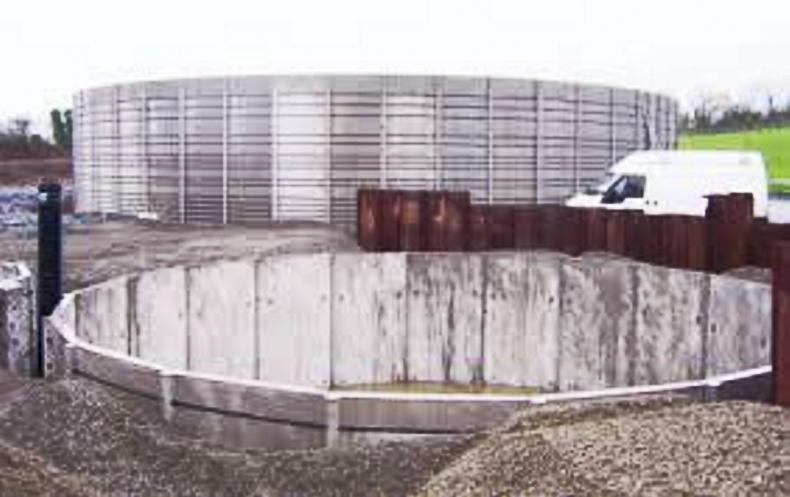
The stores can be partially or fully submerged in the ground, if necessary.
The ring beam is then left to cure for another seven days. On day 19, the final tensioning of the cables is undertaken, with the store then complete.
Application
Speaking to Moore Concrete at last week’s Balmoral Show, the company highlighted the durability of the store versus traditional steel towers being a major attraction for farmers.
“We would see a lot of farmers along the coastline contact us due to steel slurry stores rusting owing to the salt breeze.’’
The tanks have been traditionally used for agricultural applications, but have garnered increased interest in the anaerobic digestion industry for storage of digestate, Moore Concrete stated.
The tanks can be supplied with a platform, ladder and jetter for agitation purposes, or can be fitted with a side stirrer.
Reception tanks can be supplied and fitted, with the option to install a 150mm under wall or through wall draw-off.
The tanks can also be supplied with a cover at the point of erection or can be installed at a later date.
In both Northern Ireland and the Republic of Ireland, new slurry stores are now legally required to be covered. A centralised mast supports the cover internally, with the cover being both UV- and weather-resistant.
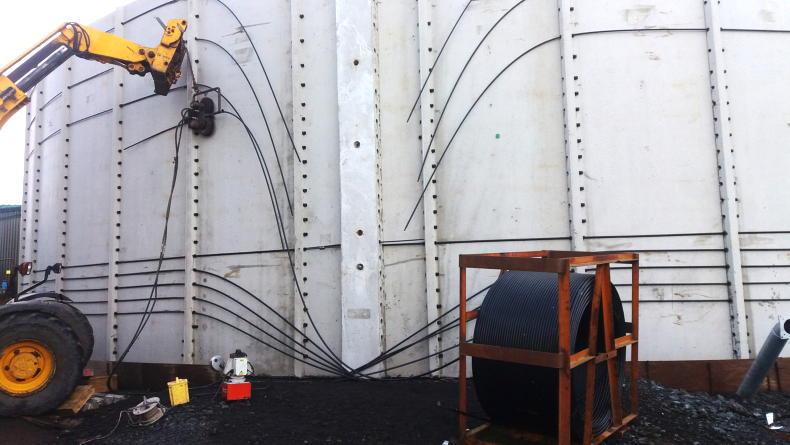
Cables encased in greased PVC sheath receiving tensioning on two occasions to support the structure and as part of the sealing process.
A feature which really sets the concrete stores ahead of traditional steel stores is that they can be partially or fully submerged in the ground.
The stores can be backfilled to a maximum height of 1m on one side, with backfilling or submerging to a greater height or depth to be discussed with the company engineer.
Price wise, farmers should contact Moore Concrete directly for an accurate quotation.
The company operates across the island of Ireland and the UK, but with each element/panel weighing up to four tonnes, only six elements can be carried per lorry load.
A 308,000-gallon store built with 6m-high panels will require 30 panels, meaning five lorry loads for the panels alone.
Similar to mass concrete tanks and steel slurry towers, value is likely to be got from higher/deeper stores than shallower/lower stores, with the 6m-high panels likely to give better value for money compared to the 4m ones.
Moore Concrete is an approved supplier of TAMS spec slurry stores. The reference cost for slurry storage is done using a linear equation on a m3 basis, which is 30.27X+ 26,919, with X being the m³ of capacity and the result.
A 240,000-gallon store comes to 1,091m3 of storage, and using our equation above, we can calculate a reference cost of €59,943.57 plus VAT.
Opinion:
concrete a solid option
for agricultural settings
Despite the recent increases in ready-mix concrete prices, concrete is very much a solid, long-term option when it comes to agricultural settings, and a concrete slurry store makes sense.
When we view the corrosion of painted slurry spreaders or even galvanised gates in slatted sheds, steel and dung/urine don’t really mix.
Concrete overhead stores could be a viable alternative, and are much easier to cover than lagoons as well, with EU legislation dictating that all new and existing stores now be covered.
Above-ground slurry stores manufactured from concrete versus traditional steel.Stores can be 4.5m or 6m in height with capacity of up to one million gallons.Stores can be completed in as little as 19 days once the site is prepped.Three-phase sealing process of joints, with a two-stage stressing of cables.A viable and long-term alternative to steel stores, especially in coastal scenarios.
As a general rule of thumb, concrete underground tanks with slats over them and animals housed directly overhead (or the slurry scraped in from nearby passageways) are the cheapest form of slurry storage.
However, when volumes start to increase as livestock numbers on-farm rise, slurry storage on a grander scale – using lagoons or overhead towers – starts to come into play from a financial point of view, generally, above 250,000 gallons.
Overhead stores
Overhead slurry towers had been the go-to for many years, but Moore Concrete, based in Ballymena in Co Antrim, has seen a growing interest in its precast concrete storage systems.
The firm creates a variety of products for agricultural use including cattle and pig slats, water troughs, fencing posts and its pre-stressed wall panels.
Pre-stressed overhead slurry stores are not new to the company, with over 200 stores built across the UK and Ireland. The Danish technology used to create the stores has been in existence for over 30 years.
Size wise, the tanks can be built from 75,000 gallons right up to 1,000,000 gallons of storage with three different tower heights to chose from; 4m, 5m or 6m.
The 4m high panels can be used to build a tower with a maximum capacity of 692,560 gallons, with 5m panels capable of 863,280 gallons of storage.
The speed at which the overhead slurry stores can be created is impressive.
Farmers are responsible for organising the clearing and preparation of the site to a suitable level base of hardcore/gravel, with Moore Concrete responsible for the remainder of the build.
Day one of the build comprises setting up the base, with pouring occurring on day two.
The bases are created with 37N concrete and are left to cure for seven days post pour before any other work is complete.

Joints are sealed internally using an expansive mortar.
On days nine and 10 of the build, the prestressed concrete panels arrive on-farm and are installed. The 6m wall panels weigh up to four tonnes, with a suitable crane used to install the panels.
Panels are propped intermittently with timbers, with the tongue and groove system of the panels allowing them to slot into each other. The post tensioning cables are then installed and given their initial stressing.
The steel cables themselves are encased in a greased PVC sheath to protect them from the elements and are threaded through holes on the outer surface of the panels.
On days 11 and 12, a special expansive mortar is used to seal the internal joints within the tank.
This is part of the three-part seal to prevent any leakages, with a bitumen strip within the tongue and grove elements in each panel, as well as the two-stage tensioning process of the cable.
While the joints are being sealed, an internal ring beam at the base of the panels is poured.

The stores can be partially or fully submerged in the ground, if necessary.
The ring beam is then left to cure for another seven days. On day 19, the final tensioning of the cables is undertaken, with the store then complete.
Application
Speaking to Moore Concrete at last week’s Balmoral Show, the company highlighted the durability of the store versus traditional steel towers being a major attraction for farmers.
“We would see a lot of farmers along the coastline contact us due to steel slurry stores rusting owing to the salt breeze.’’
The tanks have been traditionally used for agricultural applications, but have garnered increased interest in the anaerobic digestion industry for storage of digestate, Moore Concrete stated.
The tanks can be supplied with a platform, ladder and jetter for agitation purposes, or can be fitted with a side stirrer.
Reception tanks can be supplied and fitted, with the option to install a 150mm under wall or through wall draw-off.
The tanks can also be supplied with a cover at the point of erection or can be installed at a later date.
In both Northern Ireland and the Republic of Ireland, new slurry stores are now legally required to be covered. A centralised mast supports the cover internally, with the cover being both UV- and weather-resistant.

Cables encased in greased PVC sheath receiving tensioning on two occasions to support the structure and as part of the sealing process.
A feature which really sets the concrete stores ahead of traditional steel stores is that they can be partially or fully submerged in the ground.
The stores can be backfilled to a maximum height of 1m on one side, with backfilling or submerging to a greater height or depth to be discussed with the company engineer.
Price wise, farmers should contact Moore Concrete directly for an accurate quotation.
The company operates across the island of Ireland and the UK, but with each element/panel weighing up to four tonnes, only six elements can be carried per lorry load.
A 308,000-gallon store built with 6m-high panels will require 30 panels, meaning five lorry loads for the panels alone.
Similar to mass concrete tanks and steel slurry towers, value is likely to be got from higher/deeper stores than shallower/lower stores, with the 6m-high panels likely to give better value for money compared to the 4m ones.
Moore Concrete is an approved supplier of TAMS spec slurry stores. The reference cost for slurry storage is done using a linear equation on a m3 basis, which is 30.27X+ 26,919, with X being the m³ of capacity and the result.
A 240,000-gallon store comes to 1,091m3 of storage, and using our equation above, we can calculate a reference cost of €59,943.57 plus VAT.
Opinion:
concrete a solid option
for agricultural settings
Despite the recent increases in ready-mix concrete prices, concrete is very much a solid, long-term option when it comes to agricultural settings, and a concrete slurry store makes sense.
When we view the corrosion of painted slurry spreaders or even galvanised gates in slatted sheds, steel and dung/urine don’t really mix.
Concrete overhead stores could be a viable alternative, and are much easier to cover than lagoons as well, with EU legislation dictating that all new and existing stores now be covered.
Above-ground slurry stores manufactured from concrete versus traditional steel.Stores can be 4.5m or 6m in height with capacity of up to one million gallons.Stores can be completed in as little as 19 days once the site is prepped.Three-phase sealing process of joints, with a two-stage stressing of cables.A viable and long-term alternative to steel stores, especially in coastal scenarios. 







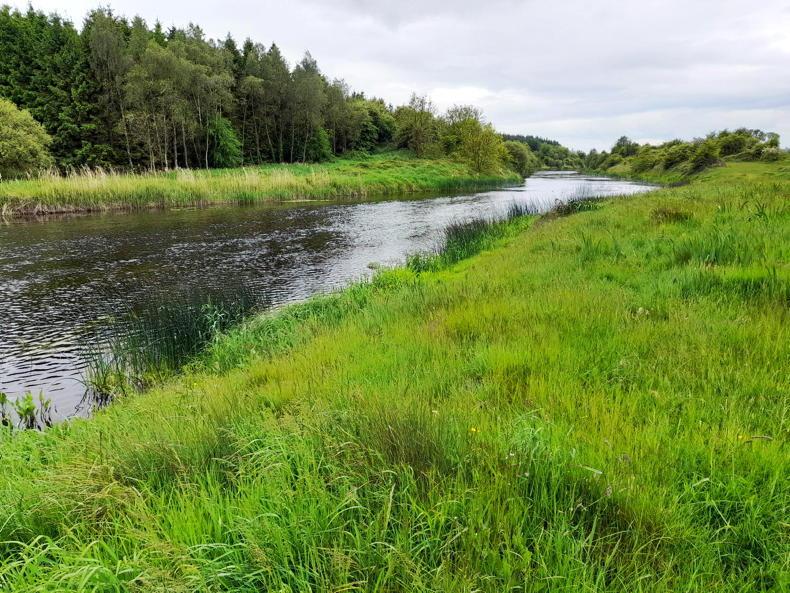


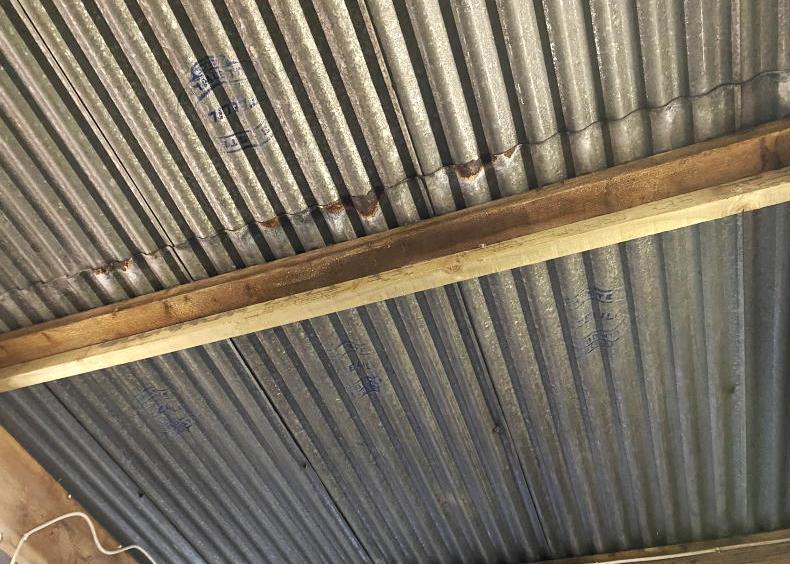
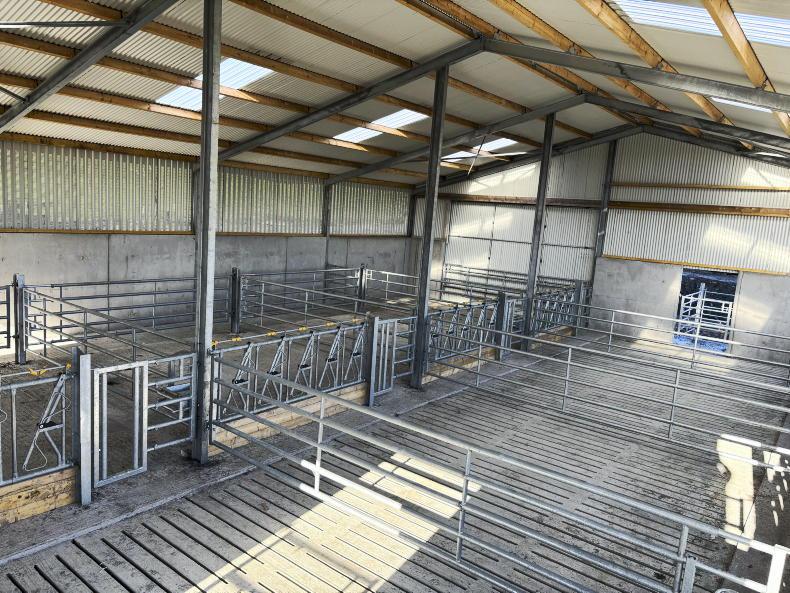
SHARING OPTIONS